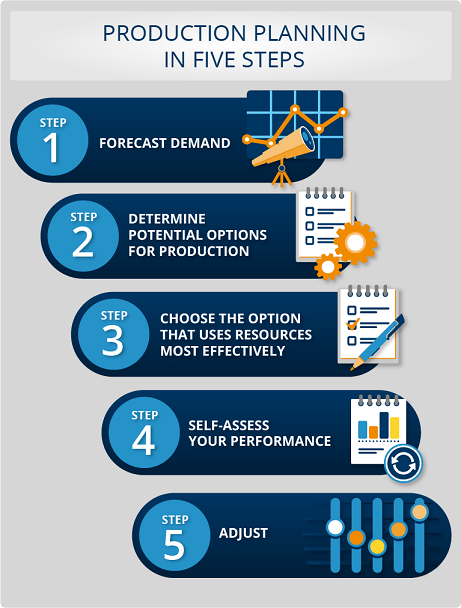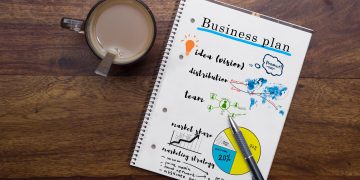Provided by the International Finance Corporation

Are you a manufacturing firm? If so, you will need a production plan to ensure that you have all the inputs for production ready at the right time to meet your product demand.
Production planning is “the administrative process that takes place within a manufacturing business and that involves making sure that sufficient raw materials, staff and other necessary items are procured and ready to create finished products according to the schedule specified”, as defined by the Business Dictionary.
A production plan serves as a guide for your company’s production activities. It establishes and sequences activities which must be carried out to achieve a production target, so that all staff involved are aware of who needs to do what, when, where and how.
A production plan will help you meet product demand while minimizing production time and cost by improving process flow, reducing the waiting time between operations, and optimizing use of plant, equipment and inventory. In order to do this, you must align your production plan to your business strategy and business plan, and support production planning by coordinating with other departments, such as procurement, finance and marketing.
The diagram above shows the production planning and control process divided in five steps:
STEP 1. Forecast the demand of your product
Estimate your demand, so that you know how many products you need to produce during a specific time period. You may have already some confirmed orders for the next couple of month, but on top of that, you need to predict how many more may come.
Different methods exist to forecast your product demand. A traditional technique to estimate product demand is based on historical information (e.g. orders placed by your customers in the past). While this is a very common method, you need to consider external and internal events in your business environment that could alter past patterns. For example, new market trends, a slowdown in the economy, or a new marketing campaign that could increase or decrease your product demand compared to what happened in the past.
STEP 2. Determine potential options for production
Determine the different production options available to meet the forecasted demand of your product. For example, if you want to produce 100 shirts, you need to use a certain number of machines, human resources, materials, and time. Different combinations of these inputs can lead to different production times and costs.
a. Start by mapping all the steps of your production process. When doing so, take into account if tasks are sequenced or dependent on other tasks, or if they happen simultaneously or independently. Below is an example of how a simple process-mapping flowchart could look. Each box represents a task of your production process. The map of the production process will be different and unique to each company. Think about how to improve process flow by eliminating bottlenecks.

b. Determine the resources needed to complete each task involved in your production process.
Look at how different combination of resources lead to different production times and costs:
- Human Resources. Determine the number of staff that will be involved in each phase of the production process, their availability, and the cost. Make sure their time is well utilized.
- Machinery and Equipment. Identify the machines needed and their availability, including any maintenance or replacement that may be needed.
- Materials. Make a list of all the materials needed for production and how you obtain them. Assess the reliability of your suppliers, including delivery time. Having materials available when needed is crucial for the production process.
- Inventory. It is important that you consider how to optimize your inventory. Keeping a large inventory is expensive, but keeping a low inventory is risky if demand fluctuates on a regular basis. Having a good inventory control system in place can help your firm accommodate variations in demand and mitigate possible problems or delays that may occur during the production process. For more information about how to manage your inventory, check out the video.
STEP 3. Choose the option for production that uses the combination of resources more effectively
Compare the cost and time of each potential production option and choose the option that uses the most efficient combination of resources and that allows you to meet product demand. The chosen option should maximize the operational capacity of your firm.
Always make sure you can cover the costs involved in the production process (purchase of materials, office rent, payment of staff salary, leasing, etc.)
You need to share your production plan with all the departments and staff that contribute or interact with the production process, including human resources, procurement, finances, marketing, etc. If everybody knows what to do, and what materials and equipment should be used for each task of the production process, operations will be smoother.
STEP 4. Monitor and control
You want to ensure that your plan is working in the way it is intended. Monitoring and controlling is about comparing what is happening with what should be happening. Having a control system in place helps you detect problems as soon as they occur, allowing you more time to correct before it is too late.
STEP 5. Adjust
Be prepared to adjust the plan if needed. The production plan needs to be flexible to accommodate changes in customers’ demand (e.g. an important order that gets cancelled). Also, you need to take into account possible risks that may arise during the production process (e.g. a machine breaks, a worker gets sick or a supplier does not deliver on time) and have a risk mitigation plan.
Inventory is the value of materials and goods held by an organization (1) to support production (raw materials, subassemblies, work in process), (2) for support activities (repair, maintenance, consumables), or (3) for sale or customer service (merchandise, finished goods, spare parts), as defined by the Business Dictionary.
Inventory optimization is a method of balancing capital investment constraints or objectives and service-level goals over a large assortment of stock-keeping units while taking demand and supply volatility into account, as defined by Wikipedia
Copyright © 2000 – 2017, International Finance Corporation. All Rights Reserved.
2121 Pennsylvania Avenue, N.W., Washington, D.C. 20433, www.ifc.org
The material in this work is copyrighted. Copying and/or transmitting portions or all of this work without permission may be a violation of applicable law. IFC does not guarantee the accuracy, reliability or completeness of the content included in this work, or for the conclusions or judgments described herein, and accepts no responsibility or liability for any omissions or errors (including, without limitation, typographical errors and technical errors) in the content whatsoever or for reliance thereon.









